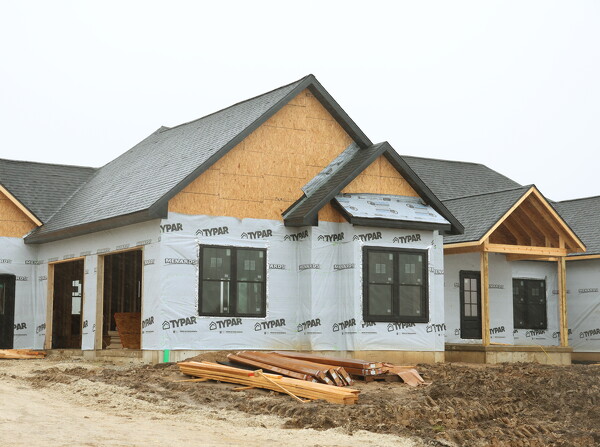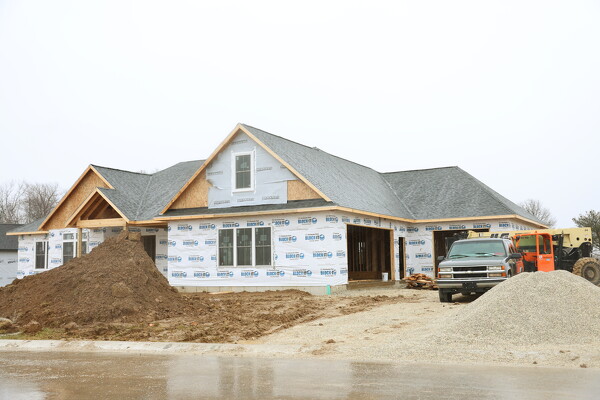
Construction continues on two neighboring houses on Eaglebrook Parkway in Celina.
CELINA - Legislation working through council chambers would allow for 100% tax abatements on newly built residential structures for 10 years, an incentive city officials hope will spur construction and make homes more palatable to potential buyers.
City councilors this week passed first reading of legislation amending the Community Reinvestment Area of 1981 to include tax exemption for the construction of residential structures.
If approved on final reading, the legislation, which contains an emergency clause, would take effect immediately.
"We had a lot of discussions on this and thought it was prudent to incentivize and encourage people with residential development," said councilman Eric Baltzell.
The legislation is intended to stimulate housing construction.
"Celina is a great place to live and we want people to be able to experience that, and the builders that are looking to build, it gives them another tool in the toolbox to help incentivize buyers here," mayor Jeff Hazel said.
Residential abatements exist in other communities, including St. Marys' Community Reinvestment Area that encompasses most residential neighborhoods, according to St. Marys Public Service and Safety Director Greg Foxhoven.
"We've had more and more of a housing deficit going forward and we've been approached by a couple different … contractors/homebuilders that are looking to kind of level the playing field with other communities that give these incentives," Hazel told the newspaper.
Plus, hesitant buyers may be more likely to commit to homes knowing the savings they reap from the abatement would help tide them over for a decade.
"If they could save five or six thousand dollars a year up front, they'd be more likely to buy it on a mortgage to do that and then as they earn more money in their jobs, they'll be able to accommodate that tax burden in ten years down the road," Hazel said.

Construction continues on two neighboring houses on Eaglebrook Parkway in Celina.
Should the amendment be enacted, the owner of a newly constructed residential structure would have to file an application with the city to receive the abatement, Hazel said. If it meets the city's requirements, it would then be forwarded to Celina City Schools Board of Education for consideration.
According the Mercer County Auditor's Office website, 76% of Celina property taxes in tax year 2022 were distributed to the school.
"The school board then is ultimately the one that has the final say-so of yes or no on it, not the city," Hazel said.
Approved tax abatements would run with the property for 10 years, even if ownership changes hands, he added. The abatement would only apply to the new structure, not the land.
Hazel believes the overall benefits of new housing construction to the community outweigh the temporary loss of property taxes, equating tax abatement to an investment or annuity that begins paying out in 10 years.
"If these folks decide to go somewhere else and build, we're still stuck with just having the land value. You're not getting any money now and you won't get any then," he said. "(We're) not taking away taxes that are already being paid."
Depending on how the economy shapes out this year, Hazel thinks the proposed tax exemption may result in new homes.
"I could see a couple of these local folks that have that ability automatically going ahead … and starting to build," he said.
Celina's Community Reinvestment Area was established in 1981 to encourage job growth and home improvements. It allows for tax exemptions for 15 years on the construction of industrial structures and 10 years on the remodeling of dwellings containing no more than two family units upon which the improvements cost at least $2,500.
Then in 2013, city councilors added a provision allowing for 12-year tax abatements on the construction of commercial structures and the remodeling of commercial and industrial properties upon which the improvements cost at least $5,000.
Various community stakeholders agree Celina and the surrounding area are in desperate need of new housing, a problem that if left unaddressed will hinder economic growth. The problem is by no means unique to the area.
Many factors have contributed to the national housing market's chronic shortage of homes for sale, including more than a decade of below-average new home construction and demographic trends that have led to homeowners hanging on to their properties longer.
While homebuilders have stepped up construction, the biggest source of for-sale inventory is homeowners who put their home on the market. But years of soaring home prices and the large gap that exists between where mortgage rates are now and where they were just a couple of years ago has discouraged many who locked in rock-bottom rates from selling.
The average rate on a 30-year mortgage has declined in recent weeks since reaching 7.79% in late October, and was at 6.66% as of this week, according to Freddie Mac.
- The Associated Press contributed to this article.



